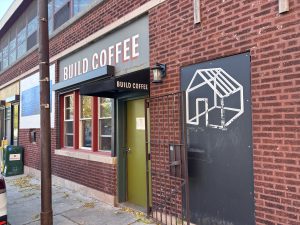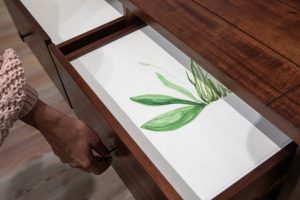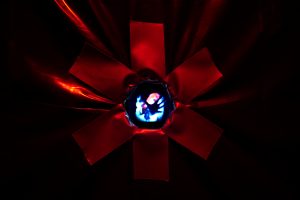Malina Simone and Alan Bacon are artists and arts administrators from Indianapolis, Indiana. As self-identified preacher’s kids with service-oriented hearts, they have dedicated their lives and careers to using the spiritual disciplines they learned growing up in church to fuel their careers as cultural workers. Today, they are the founders of GANGANG, the cultural impact and social justice powerhouse that produces the BUTTER Fine Art Fair, an equitable art fair that happens annually in Downtown Indianapolis. A week before the 2024 BUTTER Fine Art Fair, we joined a Zoom call to chat about how Mali and Alan’s spiritual architecture informed their process as cultural workers, the divine origins of GANGANG, the power of prophecy, the church as fertile soil for creative nurturing, and more.
This year’s BUTTER will take place August 28 – 31 in Indianapolis, IN. Learn more about the 2025 iteration of the fair. To purchase tickets, click here.
![Image: Portrait of Malina Simone and Alan Bacon. Alan Bacon [left] is standing with his arms in front while looking directly at the camera. He is wearing an orange, floral shirt, slacks, and brown shoes. Malina Simone [right] is standing with her hands behind her back with her head slightly tilted while looking directly at the camera. She is wearing a bright orange dress and teal heels. Photographed by Polina Osherov for GANGGANG](https://sixtyinchesfromcenter.org/wp-content/uploads/2024/10/image-683x1024.png)
Natalie James: What is each of your spiritual architecture, and how did God play a role in your life growing up?
Malina Simone: Spiritual architecture is a really interesting phrase. Right away, I think about my spiritual life and I think about my church upbringing. And I now know those are distinct. There is my spiritual life, my seasons, and the way those have evolved, and there’s also the way I was raised in church. Those are integrated to form my lens. But what I’ve learned the most is that they are distinct.
I grew up in church. We had to go to Sunday school and church, and if there was an afternoon service, we stayed. In late middle school and high school, I was in the choir. I was in the church. My parents were involved too. My dad was a minister and did a lot of outreach. What he did for a living was being a minister. He taught us that what we do on the weekends and what we do as a normal daily practice is ministry and it is what we’re supposed to do. The way that I learned about the arts as a community tool was [through] my dad saying we pick up trash in our neighborhood and cook for other people, and we barbecue because they don’t have anything to eat. This is what we do. Even before knowing what that was called, we were leveraging arts and humanities to be the light and to be a broker for the spirit, and to be examples of Christ.
The arts naturally bled into that for me and it wasn’t until I had a career with an arts title that it clicked for me. The programming that I do on the weekends, the open mic nights, the T-shirts that I sell to get money to my artist friends, everything we do, they call it ‘arts administration’.
Alan Bacon: My spiritual architecture is similar. My father was a pastor and preacher. So GANGGANG is being led by two PKs; that’s kind of cool in itself. Growing up, I came from a family of musicians. I was playing drums in the church as a kid. My spiritual architecture grew within that lens. Seeing the connectivity between what is art and what is spiritual is from that lens of being a musician.
Playing music in the church, even from a young age, I saw how it was natural and innate if you go back to the diaspora when everything was stripped from us. When we landed here from ships, we had no music, no fashion, no literature, no art, no writing, no spoken word, no languages. All of that was stripped. There was this forgotten history. I think every Renaissance period, from the negro spirituals during slavery to the Harlem Renaissance during Jim Crow, 1960s—and we’re talking about Curtis Mayfield, Maya Angelo, Marvin Gaye, Stevie Wonder, and Jimmy Hendrix—there’s the intersection of art and activism. What happens in every one of those periods is the remembrance of us is amplified a bit more. What was taken from us during the diaspora got us out of slavery. It helped liberate us from that form of captivity. We’re in another form of captivity right now, and art is also taking a stance and amplifying what that looks like. Spiritual connection to art is innate in the culture of people who are remembering themselves.
NJ: How does each of your spiritual architecture translate to the work of GANGANG?
AB: We lost our fathers last year. That was a very big blow, losing that life guidance. But the refocus was then on the Father in heaven. So we now have a stronger sense of belonging, wanting to connect to and learn and to be guided and used as a vessel in this moment. Knowing that GANGANG is an instrument, we’re going to take that divine inspiration as leadership. That is the heart of it. That’s the cornerstone of our faith. Losing a father but really starting to grow with the Father in heaven, that’s bled throughout the work. Especially in the past 18 months going through what we’ve been through.
MS: I think about two years before that. GANGANG is turning four in November. The first two years were also very much divine. GANGANG’s origin—we don’t get to talk about that night publicly in the way we might with you. It was June 4th or 5th. And I received a prophecy. I received a download. It was very clear it was a moment. I saw something right away that I can still see. It was an instant download. I knew who to call, I knew who our first funders would be. I could write the concept paper in a weekend because I knew, just like that. Because of our spiritual architecture, because I’m already in a relationship with the Lord, I can recognize an event like that for what it is.
So when you ask the question, “Where do the worlds meet?” or “How did it come to be a career?” in a moment when the world needed an answer and when our city quite literally was calling and saying, “What are we supposed to do?” It very much was, “God, what do we do? Where is the answer?” And I’m telling you, we just wrote. We said it, and it all came out. We built it that night. And we are still following that.
AB: We were on the couch not speaking and [Mali] said, “What do you think about a cultural start-up?”. And at that point, it was like Jay-Z and Nas were freestyling. We were like, pause. And we taped it. We regurgitated everything that we were talking about. We started from the beginning and kept going. We still have that tape. And everything that we had said in that video, from the most outrageous thing we could think of has happened in real life. And that’s the power of prophecy. Everything that was said was exact. No one has seen the full tape of that joint and probably never will. But that’s the lead in all of this and what it will continue to be.
I’m an artist and she’s a phenomenal writer and has worked in art administration; we knew art was the answer off the top. We knew that was the modality within what this thing would be and become.
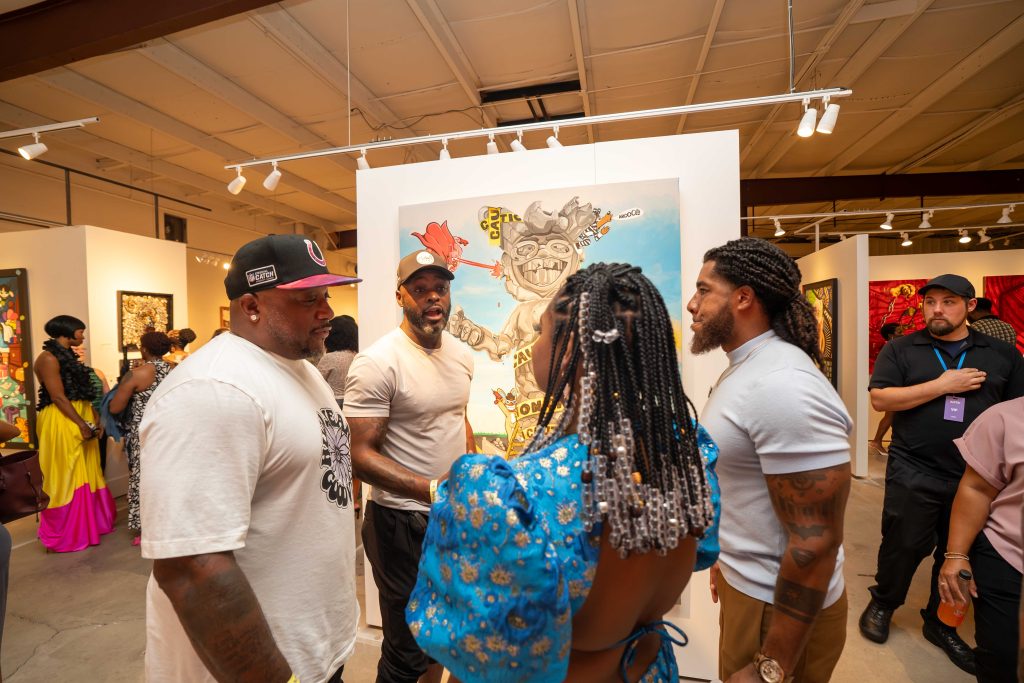
NJ: Now you work alongside all of these incredible artists who have their own spiritual architecture and creative foundations. So what do you find to be their creative foundations and their reasons for doing the work that they do?
MS: [For] a lot of the artists, it feels like they have to do this. They have to create. There’s something that they have to get out. Whether or not there’s a BUTTER or whether or not they even understand infrastructure around selling, they have to do it. And the artists here in Indianapolis are doing it within a city that does not have the infrastructure to support them, so they’ve just been doing it. We have artists and people who just know they are artists, and that is their being. This work is in service to them and the recognition that we are amongst artists. Like you said in your prayer, they are why we are able to keep going. They are telling the stories for us and opening ways for us to understand what we’re walking through. We are in service to the ones who know who they are. They’re committed to creating. Those are the types.
AB: The creative foundation is a lot. It goes back to the days of Indiana Avenue, the richness of Black culture and art in that area that has been decimated by redlining, as the story goes, in every major city in America. That happened to us. The descendants of those artists and those makers and those entrepreneurs, they’re still here. We are literally them.
Art has continued to be a platform that our city has been able to enjoy and amplify. Some of the artists that are featured in BUTTER were some of the artists who helped construct the Black Lives Matter mural on Indiana Avenue back in 2020, two or three months before GANGANG’s inception. I think about the call and response and responsibility. That’s the beautiful thing about our artists, how responsive they are.
NJ: What does it mean for creative gifts to be nurtured in the church or other spiritual spaces, and what connections do you see between spiritual or religious institutions and art practices?
AB: Yeah, it’s because things are so siloed. There are the haves and the have-nots. I think as it relates to church culture and art and music, it’s still a hotbed of growth, creativity, and ingenuity. That’s where you get all your chops from. It’s also being led by the spirit, not by the studio. You can tell the difference; you can feel it when it’s live. There’s a certain aspect of being led in the spirit and what that does. David prayed the evil spirit out of Saul [with a harp]. Elijah asked for somebody to play music so he could do a miracle. It’s always connected to our faith and our background as it relates to music in ways that only a spiritual relationship can do. And I think that we continue to see that.
I think GANGGANG and BUTTER, and I Made Rock ‘n’ Roll; we’re trying to put a bit more amplification on our creative nature and how amazing we are. At the same time, we’re working to show other aspects of the creative sector. What does gigging look like within the creative economy? How can you do this and make money? If you do the website at church, you can do the website at this company. We’re finding the creatives and finding pathways that can be a bit less saturated as far as the opportunities.
NJ: Do you think that spiritual institutions in Indianapolis could play a role in the cultural Renaissance that’s happening?
AB: I think they are.
MS: I wonder if we are realizing the pipeline of talent that exists in the church and how there could be a stronger relationship between the nonprofit arts landscape and the church. They seem so separate, but how can we blend them with infrastructure, critical thinking, and workforce development?
AB: That’s also just a big narrative as a whole, [art] not being in a sector that is necessarily respected like tech or advanced manufacturing or agriculture or education. Those sectors get so much government funding, and we’re fighting over scraps.
So I think we’re trying to be a bit more declarative as far as this is not just decorative. We’re going to challenge the dichotomy and the value of work. How can we ensure what we produce continues to allow the producers to get what they’re making at cost and build the local economy?
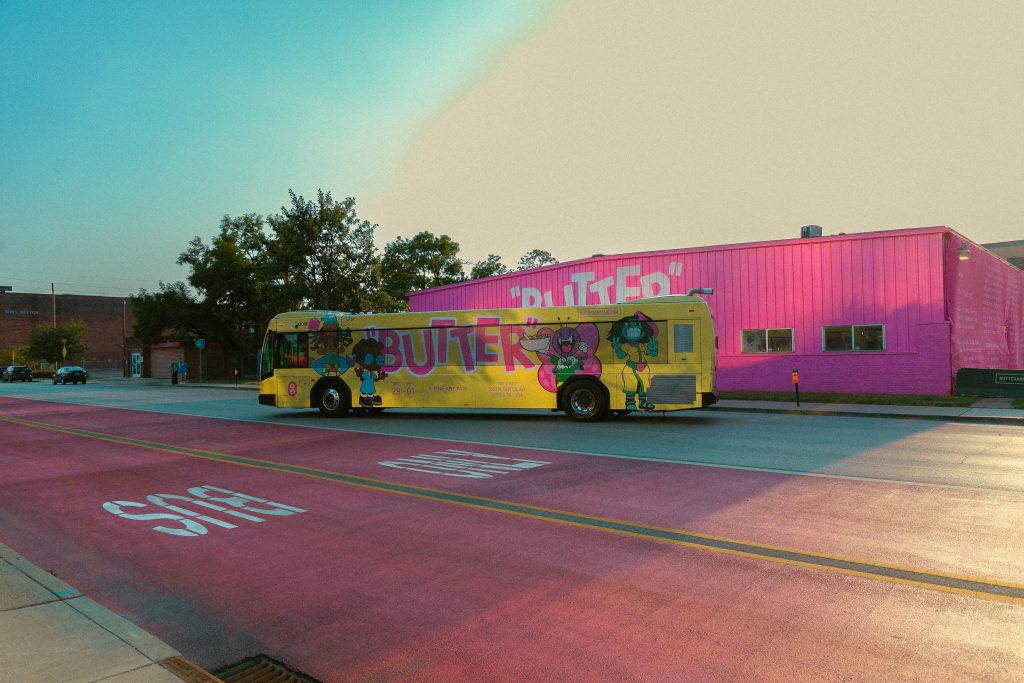
NJ: What have been some of the biggest challenges concerning the local culture that y’all have faced in doing this work?
MS: Beyond our local culture and just like the seasonal mood of society towards the arts and conversations on equity. The fluctuation of that from a broader scale is disheartening. On a state-wide level, I think Indianapolis is a much different place than Indiana or even Central Indiana. We can kind of sense the reprioritization of the arts. Budget cuts for the arts, we can tell that’s happening.
AB: There has been an economic boom. We have grown astronomically since 2020. The city has grown in a lot of various ways. You see a lot of public/private philanthropic sectors kind of wrap their hands around this notion, this intersection of art and culture and maybe sports. What does that look like? I think there’s some learning happening and a lot of impact that has been made in a very short amount of time.
From our work being the creative directors for March Madness, we led the art and culture committee for NBA All-Star Weekend, I Made Rock ‘n’ Roll, BUTTER, that’s GANGGANG. That’s all these other entities and individuals and artists that are doing so many amazing things. So many public institutions are now starting collections. Philanthropic groups are now looking at how they can support local artists and get them studios. I think the narrative of the city is changing a bit and that’s due to the actual city really wrapping their arms around what is moving, what is transforming. I think a lot of that learning is coming about quickly.
NJ: Have you seen any shifts in terms of hyper-local folks who come to BUTTER? I witnessed BUTTER and was like oh my God I didn’t realize we could have a platform like this. I recognized how powerful it was once I saw it. Have you witnessed any mindset shifts?
MS: Well, absolutely, from the artist’s perspective. The conversation we’re having right now from a curatorial perspective is interesting, and it is telling of the mindset shift of the artists. For BUTTER One and even for BUTTER Two, we were getting information from the artists about their artwork, including pricing, and we had to have real conversations with them about their own value and how much more they could be charging for their work. We had to educate and empower them. The conversations we’re having this year are, “OK, we can’t sell this work at this price. The market is not here.” It’s very interesting how the artists feel. They’re like, this is who I am, I know my worth now because of BUTTER. It’s interesting to see the market shift but also the mindset of the artists and them recognizing their value.
AB: And I think the attendees, like regular Black people, come to BUTTER. There’s a sense of dignity, there’s a sense of pride, and there’s this sense of remembrance and nostalgia. It’s family being able to connect together to see what love looks like and feels like. All ages and demographics centered around the very loud voice of ART.
People who come experience BUTTER from all the senses. There’s the food and music and all the sights. And you have this art component that provides experiential learning opportunities along with all the fun. You just get so much of yourself out of that. When you go to BUTTER, it’s almost like you just fill up your cup which is drained from us every single day living in captivity. There are not a lot of times you can go to a place and get refilled. BUTTER is almost like a gas station for the culture. You can fill up every day for an entire weekend.
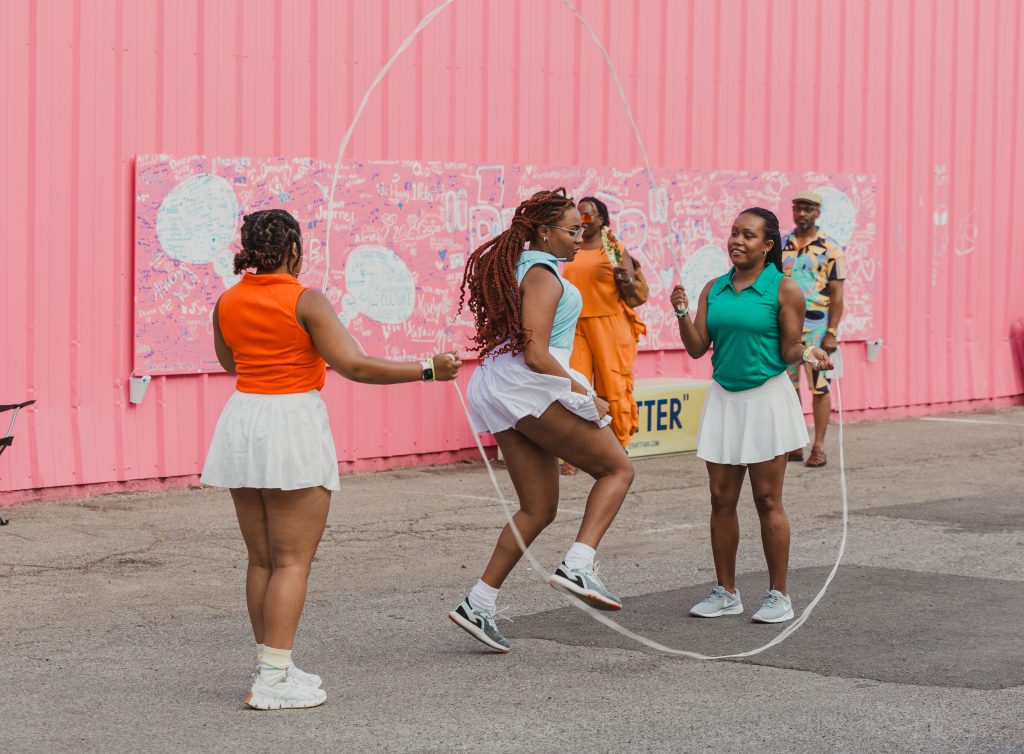
NJ: Alan, you mentioned in the GANGANG blog trailer from 2023 that one of the things about the African-American culture is that we are one of the most creative people in the world. What is the value of that collective creativity, and how can it be harnessed?
MS: I mean the value is our very survival. How do you value us? What’s the value of rock ‘n’ roll globally? What’s the value of the United States? Our creativity is the engine behind everything the world loves. It’s hard to put a value on it beyond our very survival because it comes by way of the artist. We’re talking about people. I think it was Hank Willis Thomas who said that Black creativity is the most profound because of its joy out of oppression. The theme for BUTTER this year is ‘unconquerable love’, unconquerable love which has sustained us. I don’t know how to put a value on that.
AB: Yeah, it’s the same. You’re using the power of art. It liberated people out of slavery. It wasn’t the Constitution that did that. We had to navigate and survive the 400 years of it to get to this place where we can talk about it right now. I think that’s the power we have right now. Now we have to decide how we’re going to leverage it. We’ve shared it with the world with a gun to our head. But what is it like with us in the driver’s seat when we can leverage this for good? We can leverage this to communicate, to educate, to bring people together. To help bring about remembrance and identity, that’s the next step.
NJ: What do you all feel will be the future spiritual implications of your work in the city?
MS: Hopefully more awareness of the spiritual realm, more consciousness, and more conversation about what’s beyond us above us. BUTTER three addressed evil so that it could become conscious that there is evil, there is good. We’re OK with saying those things but, what does that mean? Who is it influencing, and where is it allowed, where is it not allowed? What is it doing to you? If we can make [people] conscious [of] the forces that are influencing all of our decisions and behaviors then we can get closer to talking about them influencing decisions and behaviors.
NJ: Last question. This will come out after BUTTER Four, but what are you both looking forward to the most?
AB: I love just being around the atmosphere, the energy, the people and just the abundance of appreciation. It is fun, it is lively, it is jovial, it is cool. The experience of BUTTER really is special, one that kind of hits you in ways that you probably didn’t even know that you needed. That’s what I’m looking forward to. What is BUTTER going to give me this year that’s gonna carry me through the rest of this year, through change?
MS: I’m looking forward to trying to sell as many artworks as I can. This is a large show. There’s more than 170 pieces, and I am looking forward to hustling. And I’m looking forward to what Indianapolis is going to say after this one, after four years of this thing. I was just at a board meeting, and someone from visitINDY was in the elevator and said, “Hey, how are ticket sales going for BUTTER? We’re pumping out the paid ads.” And I thought, wow like everybody’s doing something, everybody’s working on this, and we want it to work. So I’m interested in what Indianapolis is going to say about its new fine art fair. And how it’s going to sustain it.
AB: And lastly, from an equity standpoint, we work to sell a hundred percent of the work, and 100% of the sales go back to the artists. We’re approaching BUTTER Four, and we have an opportunity this year of eclipsing 1 million dollars. And all of it going back to the hands and households of Black artists. It’s crazy, hitting the $1 million mark in four years for this equity type of mission. Its pretty special to get to that mark and to celebrate what that impact looks like.
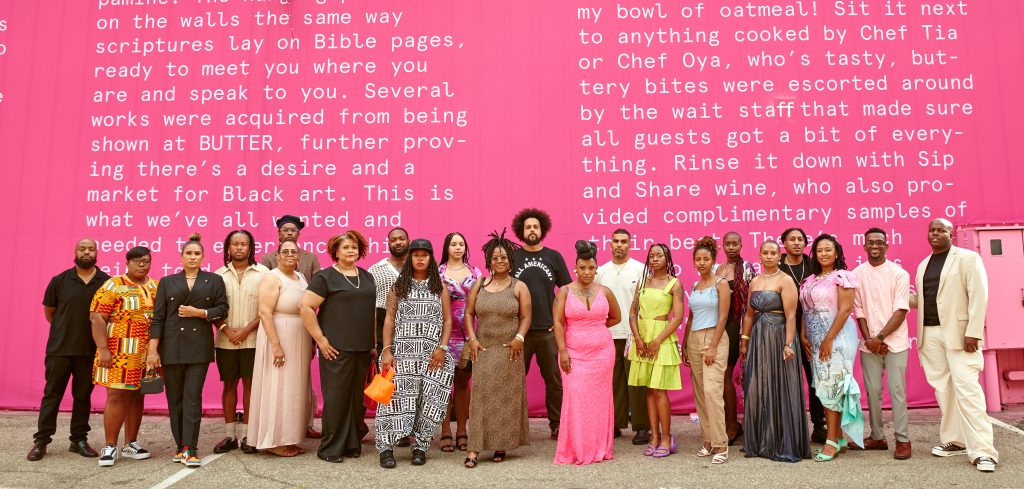
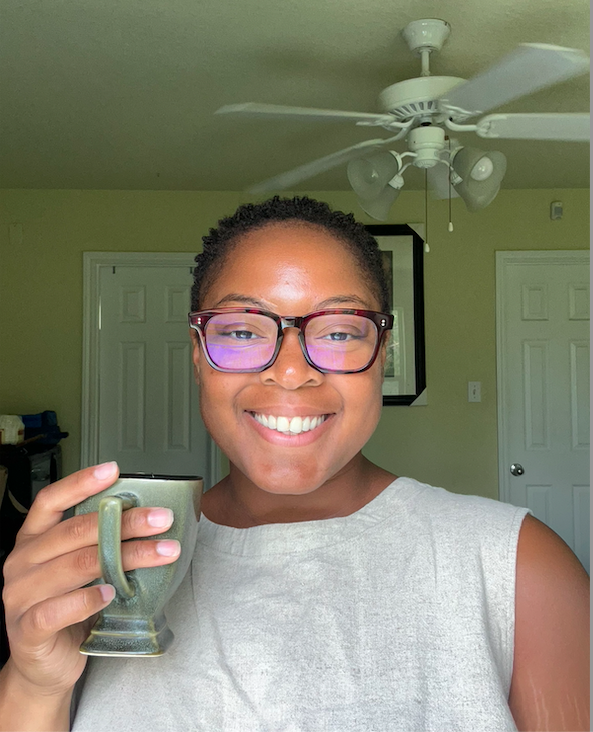
About the Author: Natalie James is a narrative journalist, art writer and storyteller based in the U.S. South. She is a daughter of the rich dark soil of the Alabama Black Belt and the life-giving mountain forests of St. James Parish, Jamaica. Raised between Montego Bay, Indianapolis, and Boston, she holds a Bachelor’s degree in Africana Studies from Smith College. As a child, Natalie began writing as a way to process emotions and has since come to understand the power of using writing as a tool for healing and liberation. Her work seeks to highlight the messages that Black artists have come to tell through their works and she always endeavors to be a conduit for the truth. Natalie began writing professionally out of financial necessity. When she needed a laptop top for graduate school and examined the ways she could make extra money, writing emerged as a pathway. After writing a series of profiles about educators during COVID-19, she knew that uplifting stories was what she wanted to do. If she could be any food, she’d be a sweet potato, and her favorite quote is from the legendary Ella Baker, “Give light and people will find the way.”

